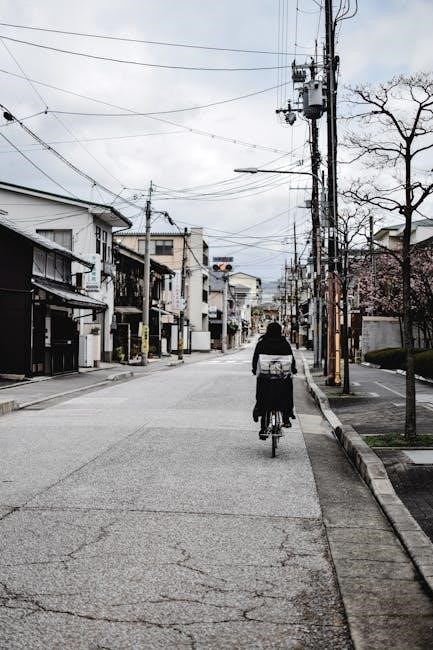
The Civilian Exclusion Orders were official directives issued during WWII, targeting individuals of Japanese ancestry. These instructions, authorized by the Western Defense Command, mandated relocation under military authority.
1.1 Historical Context of the Instructions
The Civilian Exclusion Orders were issued during World War II, following the attack on Pearl Harbor in 1941. Fears of espionage and sabotage led to the targeting of Japanese Americans. The U.S. government, under Executive Order 9066, authorized the Western Defense Command to enforce the exclusion. These instructions mandated the removal of all persons of Japanese ancestry from designated military zones, effective May 18, 1942. The orders reflected wartime paranoia and racial discrimination, profoundly impacting Japanese American communities.
1.2 Purpose of the Civilian Exclusion Orders
The primary purpose of the Civilian Exclusion Orders was to ensure national security by removing individuals of Japanese ancestry from strategic military areas. The U.S. government believed this would prevent potential espionage and sabotage. Orders like No. 33 and No. 69 directed individuals to report to Civil Control Stations, leading to their relocation to assembly centers. This measure was justified as a necessary wartime precaution, though it ultimately led to the forced displacement of over 120,000 Japanese Americans, causing significant personal and economic hardship.

Background of the Civilian Exclusion Orders
The Civilian Exclusion Orders stemmed from the Western Defense Command, led by Lt. Gen. J.L. DeWitt, under Executive Order 9066. This measure, signed by President Roosevelt in 1942, authorized the military to exclude individuals of Japanese ancestry from designated areas, ensuring national security during WWII, resulting in forced relocation and property loss for many Japanese Americans.
2.1 Role of the Western Defense Command
The Western Defense Command, under Lt. Gen. J.L. DeWitt, played a central role in issuing Civilian Exclusion Orders. These orders, authorized by Executive Order 9066, were implemented in 1942, directing the forced relocation of Japanese Americans. The WDC designated Military Areas and enforced compliance, overseeing the exclusion process to ensure national security during WWII. This military-led initiative significantly impacted Japanese American communities, leading to their removal from designated zones and relocation to assembly centers.
2.2 Key Figures Involved in the Orders
Lt. Gen. J.L. DeWitt, commander of the Western Defense Command, was instrumental in issuing Civilian Exclusion Orders. His directives, under Executive Order 9066, led to the forced relocation of Japanese Americans. Other key figures included officials within the Wartime Civil Control Administration, tasked with enforcing these orders. Their roles were pivotal in shaping the implementation of the exclusion process, which profoundly affected Japanese American communities during WWII.
2.3 Legal Framework for the Exclusion
The Civilian Exclusion Orders were legally justified under Executive Order 9066, signed by President Franklin D. Roosevelt in February 1942. This order authorized the military to designate areas from which individuals could be excluded. Public Law 503 further legitimized the orders, allowing the military to enforce relocation without due process. The legal framework, though challenged, provided the basis for the forced removal of Japanese Americans under the guise of national security during WWII.

The Exclusion Process
The Civilian Exclusion Orders outlined a systematic process of identifying military areas, reporting to Civil Control Stations, and relocating individuals to assembly centers for further processing.
3.1 Identification of Military Areas
Military areas were designated by the Western Defense Command to ensure national security during WWII. Areas deemed critical, such as coastal regions and strategic locations, were labeled as restricted zones. These designations were based on perceived threats and military necessity. The identification process led to the issuance of exclusion orders, targeting individuals of Japanese ancestry residing within these areas. The boundaries and classifications of these zones were communicated through official directives, outlining the specific regions subject to evacuation mandates.
3.2 Reporting to Civil Control Stations
Individuals of Japanese ancestry were required to report to designated Civil Control Stations by specific deadlines, such as May 18th, 1942. These stations served as processing points for relocation. Instructions mandated that individuals bring essential items, as storage for personal belongings was unavailable. Compliance was strictly enforced, with failure to report resulting in severe consequences. The process was tightly regulated, ensuring adherence to the exclusion orders. These stations played a critical role in the systematic execution of the evacuation process during WWII.
3.4 Assembly Centers and Relocation
After reporting to Civil Control Stations, individuals of Japanese ancestry were transported to assembly centers. These centers served as temporary holding facilities, often lacking adequate living conditions. Families were typically housed in overcrowded barracks with limited privacy and basic amenities. From there, they were relocated to more permanent internment camps, frequently in remote areas. The process caused significant disruption, separating families and communities. These centers marked the beginning of a prolonged period of displacement and hardship for Japanese Americans during WWII. The conditions were often harsh, exacerbating the physical and emotional strain of relocation. Many faced further transfers to other camps, prolonging their ordeal. The assembly centers symbolized the systemic uprooting of Japanese Americans, stripping them of their homes, livelihoods, and freedoms. This forced relocation had lasting impacts on their lives and communities, leaving deep scars that would take decades to heal. The process was efficient but deeply inhumane, reflecting the broader wartime policies of exclusion and fear. The assembly centers were merely the first step in a long and traumatic journey for those affected. The physical and emotional toll of these centers is a testament to the harsh realities of the exclusion orders; The relocation process was meticulously organized but lacked humanity, prioritizing military strategy over individual rights and dignity. The assembly centers remain a stark reminder of the injustices faced by Japanese Americans during this period. The conditions in these centers were often unsanitary and overcrowded, leading to health issues and further suffering. The relocation process was a complex and devastating experience that affected every aspect of the lives of Japanese Americans. The assembly centers were a critical part of the machinery of exclusion, ensuring the systematic removal of Japanese Americans from their homes. The process was carried out with military precision, leaving no room for individual circumstances or appeals. The assembly centers were a place of transition, but for many, they represented the end of their former lives and the beginning of a prolonged struggle for survival and justice. The relocation process was a dark chapter in American history, marked by the forced removal of innocent citizens based on their ancestry. The assembly centers were a key component of this unjust system, facilitating the mass internment of Japanese Americans. The conditions in these centers were often harsh, with inadequate food, shelter, and medical care. The relocation process was a traumatic experience that left lasting scars on the Japanese American community. The assembly centers were a symbol of the fear and prejudice that drove the exclusion orders. The process of relocation was deeply flawed, prioritizing national security over human rights. The assembly centers were a place of confinement, but they also served as a stepping stone to the internment camps where Japanese Americans would spend the duration of the war; The relocation process was a complex and multifaceted system that involved the coordination of multiple government agencies. The assembly centers were a critical part of this system, ensuring the efficient processing and transportation of Japanese Americans to internment camps. The conditions in these centers were often brutal, with poor sanitation, inadequate food, and insufficient medical care. The relocation process was a devastating experience for Japanese Americans, causing the loss of homes, businesses, and livelihoods. The assembly centers were a stark reminder of the injustices faced by Japanese Americans during WWII; The relocation process was a dark period in American history, marked by the forced removal and internment of over 120,000 individuals. The assembly centers were a key part of this process, facilitating the mass relocation of Japanese Americans to internment camps. The conditions in these centers were often harsh, with overcrowding, poor sanitation, and inadequate facilities. The relocation process was a traumatic experience that had long-lasting effects on the Japanese American community. The assembly centers were a symbol of the fear and discrimination that led to the exclusion orders. The process of relocation was deeply unjust, prioritizing national security over the rights and dignity of Japanese Americans. The assembly centers were a critical part of the machinery of exclusion, ensuring the systematic removal of Japanese Americans from their homes. The conditions in these centers were often unsanitary and overcrowded, leading to health issues and further suffering. The relocation process was a complex and devastating experience that affected every aspect of the lives of Japanese Americans. The assembly centers were a key component of this unjust system, facilitating the mass internment of Japanese Americans. The relocation process was a dark chapter in American history, marked by the forced removal of innocent citizens based on their ancestry. The assembly centers were a symbol of the fear and prejudice that drove the exclusion orders. The process of relocation was deeply flawed, prioritizing national security over human rights. The assembly centers were a place of confinement, but they also served as a stepping stone to the internment camps where Japanese Americans would spend the duration of the war. The relocation process was a complex and multifaceted system that involved the coordination of multiple government agencies. The assembly centers were a critical part of this system, ensuring the efficient processing and transportation of Japanese Americans to internment camps. The conditions in these centers were often brutal, with poor sanitation, inadequate food, and insufficient medical care. The relocation process was a devastating experience for Japanese Americans, causing the loss of homes, businesses, and livelihoods. The assembly centers were a stark reminder of the injustices faced by Japanese Americans during WWII. The relocation process was a dark period in American history, marked by the forced removal and internment of over 120,000 individuals. The assembly centers were a key part of this process, facilitating the mass relocation of Japanese Americans to internment camps. The conditions in these centers were often harsh, with overcrowding, poor sanitation, and inadequate facilities. The relocation process was a traumatic experience that had long-lasting effects on the Japanese American community. The assembly centers were a symbol of the fear and discrimination that led to the exclusion orders. The process of relocation was deeply unjust, prioritizing national security over the rights and dignity of Japanese Americans. The assembly centers were a critical part of the machinery of exclusion, ensuring the systematic removal of Japanese Americans from their homes. The conditions in these centers were often unsanitary and overcrowded, leading to health issues and further suffering. The relocation process was a complex and devastating experience that affected every aspect of the lives of Japanese Americans. The assembly centers were a key component of this unjust system, facilitating the mass internment of Japanese Americans. The relocation process was a dark chapter in American history, marked by the forced removal of innocent citizens based on their ancestry. The assembly centers were a symbol of the fear and prejudice that drove the exclusion orders. The process of relocation was deeply flawed, prioritizing national security over human rights. The assembly centers were a place of confinement, but they also served as a stepping stone to the internment camps where Japanese Americans would spend the duration of the war. The relocation process was a complex and multifaceted system that involved the coordination of multiple government agencies. The assembly centers were a critical part of this system, ensuring the efficient processing and transportation of Japanese Americans to internment camps. The conditions in these centers were often brutal, with poor sanitation, inadequate food, and insufficient medical care. The relocation process was a devastating experience for Japanese Americans, causing the loss of homes, businesses, and livelihoods. The assembly centers were a stark reminder of the injustices faced by Japanese Americans during WWII. The relocation process was a dark period in American history, marked by the forced removal and internment of over 120,000 individuals. The assembly centers were a key part of this process, facilitating the mass relocation of Japanese Americans to internment camps. The conditions in these centers were often harsh, with overcrowding, poor sanitation, and inadequate facilities. The relocation process was a traumatic experience that had long-lasting effects on the Japanese American community. The assembly centers were a symbol of the fear and discrimination that led to the exclusion orders. The process of relocation was deeply unjust, prioritizing national security over the rights and dignity of Japanese Americans. The assembly centers were a critical part of the machinery of exclusion, ensuring the systematic removal of Japanese Americans from their homes. The conditions in these centers were often unsanitary and overcrowded, leading to health issues and further suffering. The relocation process was a complex and devastating experience that affected every aspect of the lives of Japanese Americans. The assembly centers were a key component of this unjust system, facilitating the mass internment of Japanese Americans. The relocation process was a dark chapter in American history, marked by the forced removal of innocent citizens based on their ancestry. The assembly centers were a symbol of the fear and prejudice that drove the exclusion orders. The process of relocation was deeply flawed, prioritizing national security over human rights. The assembly centers were a place of confinement, but they also served as a stepping stone to the internment
Impact on Japanese Americans
The forced evacuation caused significant loss of property, livelihoods, and emotional trauma. Japanese Americans faced psychological distress and long-term societal effects due to the exclusion orders.
4.1 Forced Evacuation and Its Challenges
The Civilian Exclusion Orders mandated the immediate relocation of Japanese Americans, forcing them to leave their homes and livelihoods behind. Many were given just days to prepare, leading to significant emotional distress and financial loss. The orders applied to both citizens and non-citizens, creating widespread fear and uncertainty. Families were often separated, and the sudden disruption caused long-lasting psychological effects. The process was further complicated by the harsh conditions at assembly centers, where overcrowding and poor facilities exacerbated the hardships faced by evacuees.
4.2 Loss of Property and Livelihood
The forced evacuation under Civilian Exclusion Orders led to significant economic hardship for Japanese Americans. Many were forced to sell their homes, businesses, and belongings at drastically reduced prices, often losing their entire life savings. Farms, stores, and personal property were abandoned or confiscated, leaving families without financial stability. The sudden nature of the orders made it impossible for many to secure fair value for their assets, further exacerbating the economic and emotional toll of the exclusion.
4.3 Psychological and Social Effects
The forced evacuation caused profound psychological trauma, including anxiety, depression, and a sense of betrayal. Families were separated, and communities were shattered. The loss of homes, businesses, and cultural ties led to identity crises. Internment camps fostered feelings of humiliation and hopelessness. Social stigma and racism further exacerbated the emotional toll. The experience left lasting scars, affecting not only those directly impacted but also future generations through intergenerational trauma and a fractured sense of belonging in American society.
Civilian Exclusion Order No. 33
Issued on May 3, 1942, Order No. 33 mandated persons of Japanese ancestry in designated areas to report to Civil Control Stations by May 18, 1942, marking a pivotal moment in the exclusion process during WWII.
5.1 Specific Instructions for Evacuation
Civilian Exclusion Order No. 33, issued on May 3, 1942, required all persons of Japanese ancestry to report to Civil Control Stations by May 18, 1942. Individuals were permitted to bring essential personal effects but were prohibited from carrying weapons or contraband. The order specified strict adherence to designated assembly points and timelines, with failure to comply resulting in severe consequences. This directive marked a critical step in the systematic relocation process during WWII, impacting thousands of Japanese Americans.

5.2 Compliance Requirements
Individuals of Japanese ancestry were required to comply strictly with evacuation orders, reporting to designated Civil Control Stations by specified deadlines. They were permitted to carry only essential items, excluding weapons or contraband. Compliance involved presenting necessary documents and adhering to instructions from authorities. Failure to meet these requirements could result in severe legal consequences. The orders emphasized the importance of timely reporting and cooperation to avoid penalties, ensuring the process unfolded as dictated by military directives during WWII.
5.3 Consequences of Non-Compliance
Non-compliance with the Civilian Exclusion Orders resulted in severe legal repercussions, including arrest and prosecution under federal law. Individuals who failed to report to Civil Control Stations faced imprisonment and fines. Additionally, non-compliance was viewed as defiance of military authority, further escalating tensions. The consequences underscored the rigid enforcement of the orders, emphasizing the government’s strict stance on national security during wartime. Those who resisted faced not only legal penalties but also social ostracism and prolonged detention in internment camps.

Role of the Civilian Control Stations
Civilian Control Stations served as processing centers, handling documentation and organizing the relocation of Japanese Americans. They were the primary points for reporting and receiving further instructions.
6.1 Functioning of the Stations
Civilian Control Stations functioned as central hubs for processing individuals of Japanese ancestry. They handled registration, documentation, and managed the assembly process. Staffed by military and civilian personnel, these stations operated under strict schedules, typically between 8 a.m. and 5 p.m. Individuals were required to bring essential items and personal belongings. The stations played a crucial role in organizing the relocation, but their operations were often marked by confusion and distress among those forced to comply.
6.2 Processing and Documentation
The processing at Civilian Control Stations involved thorough documentation and strict control. Individuals of Japanese ancestry were required to present identification and personal records. Officials oversaw the assembly, ensuring compliance with the exclusion orders. The documentation process was meticulous, tracking each person’s details and movements. This systematic approach facilitated the relocation but added to the stress and uncertainty faced by those affected. The records served as a means to monitor and manage the population effectively.
6.3 Conditions at the Stations
The Civilian Control Stations were often overcrowded, with inadequate facilities and resources. Individuals faced poor living conditions, limited privacy, and significant emotional distress. The stations served as temporary holding areas, where families waited before being transported to relocation camps. The environment was stressful, with uncertainty about the future weighing heavily on those detained. Despite efforts to maintain order, the stations reflected the harsh realities of the exclusion process, emphasizing the difficult circumstances faced by Japanese Americans during this period.
Legal and Ethical Controversies
The Civilian Exclusion Orders raised significant constitutional concerns, violating due process and equal protection principles. The Supreme Court upheld the orders in Korematsu v. United States, sparking ethical debates about racial discrimination and national security.
7.1 Constitutional Challenges
The Civilian Exclusion Orders faced intense constitutional scrutiny, primarily under the Fifth Amendment. Critics argued that the orders violated due process and equal protection by targeting individuals based solely on their Japanese ancestry. The Supreme Court’s decision in Korematsu v. United States upheld the orders, citing national security concerns. However, this ruling remains controversial, with many legal scholars asserting that it set a dangerous precedent for racial discrimination under the guise of emergency measures.
7.2 Public Reaction and Debate
The Civilian Exclusion Orders sparked significant public debate, with opinions divided on their necessity and morality. Many supported the measures, citing national security concerns amid wartime fears. Others condemned the orders as racially discriminatory, violating basic rights. Media and political rhetoric often fueled anti-Japanese sentiment, while advocates for Japanese Americans argued for their loyalty and contributions to society. The debate highlighted deep-seated prejudices and the tension between security and civil liberties, leaving a lasting impact on public perception of the Japanese American community.
7.3 Long-Term Legal Implications
The Civilian Exclusion Orders set a troubling legal precedent, challenging constitutional rights and racial equality principles; Courts initially upheld the orders, but later rulings, such as Korematsu v. United States, were widely criticized for justifying racial discrimination. Decades later, the U.S. government formally apologized and provided reparations, acknowledging the grave injustice. These events underscored the importance of judicial scrutiny and the need to protect civil liberties, even during national crises, influencing future legal frameworks and human rights protections.

Societal Reaction and Support
Public reactions varied, with fear and patriotism often overshadowing solidarity. Japanese American community leaders advocated for compliance, while others protested the orders, sparking debates about justice and equality.
8.1 Community Responses to the Orders

Community responses to the exclusion orders were deeply divided. Many citizens, driven by wartime fear and patriotism, supported the measures, while others expressed solidarity with Japanese Americans. Local leaders and organizations advocated for their rights, challenging the legality and morality of the orders. The instructions sparked widespread debate, with some communities actively resisting the policies. Meanwhile, Japanese American communities themselves faced immense pressure to comply, leading to a mix of cooperation and quiet defiance.
8.2 Role of Japanese American Community Leaders
Japanese American community leaders played a crucial role in guiding their communities through the exclusion process. Many leaders worked tirelessly to provide emotional and practical support, helping individuals understand and comply with the orders. They also played a key role in organizing resources and maintaining community cohesion. Some leaders advocated for resistance, while others encouraged cooperation to ensure safety. Their efforts were vital in navigating the challenges posed by the exclusion orders, balancing compliance with the preservation of cultural identity and community resilience.
8.3 External Support and Advocacy
External supporters, including educators and advocacy groups, played a vital role in raising awareness about the injustices faced by Japanese Americans. They created educational resources, such as lesson plans, to highlight the historical significance of the exclusion orders. Museums and digital archives provided access to documents and personal stories, fostering empathy and understanding. These efforts helped preserve the history of Japanese Americans and promoted a more equitable society by advocating for justice and remembrance.

Resistance and Non-Compliance
Some Japanese Americans resisted the exclusion orders through legal challenges and public defiance, highlighting the moral and constitutional dilemmas of the policies. Their actions sparked widespread debate and drew attention to the injustices faced during WWII.
9.1 Cases of Resistance
Several Japanese Americans actively resisted the exclusion orders through legal challenges and public defiance. Notable cases included lawsuits questioning the constitutionality of the orders, while others refused to comply, facing arrest. Community leaders and activists organized protests, emphasizing the injustice of targeting citizens based on ancestry. These acts of resistance highlighted the moral and legal dilemmas of the exclusion policies, inspiring broader debate about civil liberties during wartime.
9.2 Consequences of Defiance
Individuals who defied the Civilian Exclusion Orders faced severe repercussions. Non-compliance resulted in immediate arrest, fines, and imprisonment; Those who resisted were often stripped of their property and rights, facing societal ostracism. The legal system enforced penalties rigorously, emphasizing the government’s authority. Defiance also led to prolonged detention in harsh conditions, further isolating families and communities. These consequences underscored the high stakes of challenging the exclusion orders during wartime.

9.3 Notable Individuals Who Resisted
Several individuals famously resisted the Civilian Exclusion Orders. Fred Korematsu defied the orders and took his case to the Supreme Court, arguing the unconstitutionality of the exclusion. Gordon Hirabayashi also resisted, challenging the curfew and exclusion orders in court. Mitsuye Endo’s legal battle led to a landmark Supreme Court decision that effectively ended the internment. These individuals risked imprisonment and societal backlash to stand against the unjust orders, leaving a lasting legacy of resistance and advocacy for civil rights.
Post-War Developments
Post-war, Japanese Americans gradually rebuilt their lives, facing ongoing societal challenges. The government later issued apologies and compensation, acknowledging the injustice of the exclusion orders.
10.1 Reintegration of Japanese Americans
Following the war, Japanese Americans faced significant challenges reintegrating into society. Many returned to find their homes and businesses destroyed or appropriated. Despite this, communities gradually rebuilt, with efforts supported by cultural resilience and collective determination. The process was slow, marked by lingering discrimination, but ultimately laid the foundation for healing and recovery.
10.2 Government Apologies and Compensation
Decades after the exclusion, the U.S. government formally apologized and provided compensation to Japanese Americans. In 1988, President Reagan signed the Civil Liberties Act, offering $20,000 to each surviving victim of the internment. This act acknowledged the injustice and constitutional violations committed during WWII, marking a significant step toward reconciliation.
The apology and compensation symbolized a national acknowledgment of wrongdoing, aiming to heal historical wounds and ensure such injustices would not recur.
10.3 Legacy of the Exclusion Orders
The Civilian Exclusion Orders left an enduring impact on American history, serving as a cautionary tale about racial discrimination and the dangers of fear-driven policies. They prompted significant legal reforms and heightened awareness of civil rights, influencing future protections for minority groups. Today, the orders are studied to reflect on issues of justice and equality.
Educational Resources and Awareness
Educational resources, including lesson plans and digital archives, provide insights into the Japanese American WWII experience, fostering reflection on its historical and contemporary significance.
11.1 Lesson Plans and Curriculum

Educational resources include detailed lesson plans that explore the Japanese American WWII experience. These curriculum materials are designed for schools, focusing on the historical context of the exclusion orders, personal stories, and their lasting impact. They emphasize critical thinking and empathy, encouraging students to reflect on the ethical and societal implications. Many plans incorporate primary sources, such as the Civilian Exclusion Orders, to provide an authentic learning experience. These resources are widely available, often provided by museums and educational institutions, to promote awareness and understanding of this significant chapter in history.
11.2 Museums and Exhibits
Museums like the Japanese American National Museum (JANM) offer exhibits that document the Japanese American WWII experience; These exhibits feature artifacts, photographs, and personal stories related to the Civilian Exclusion Orders. They provide a visual and emotional understanding of the incarceration and its impact on families. Interactive displays and historical documents, such as the exclusion orders themselves, are key components. These exhibits serve as educational tools, fostering empathy and awareness of this significant historical event.
11.3 Digital Archives and Research Materials
Digital archives provide extensive resources on the Civilian Exclusion Orders, offering scanned documents, photographs, and personal testimonies. Institutions like the Japanese American National Museum (JANM) and the Library of Congress host online collections. These archives include digitized exclusion orders, wartime correspondence, and oral histories. Researchers and educators can access these materials for in-depth study. Online databases also feature lesson plans and multimedia presentations, ensuring the history remains accessible and educational for future generations.
12.2 Reflection on Historical Significance
The Civilian Exclusion Orders marked a tragic chapter in history, highlighting the violation of civil liberties during wartime. They serve as a reminder of resilience and the importance of upholding justice and equality for all citizens.